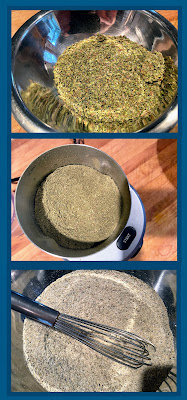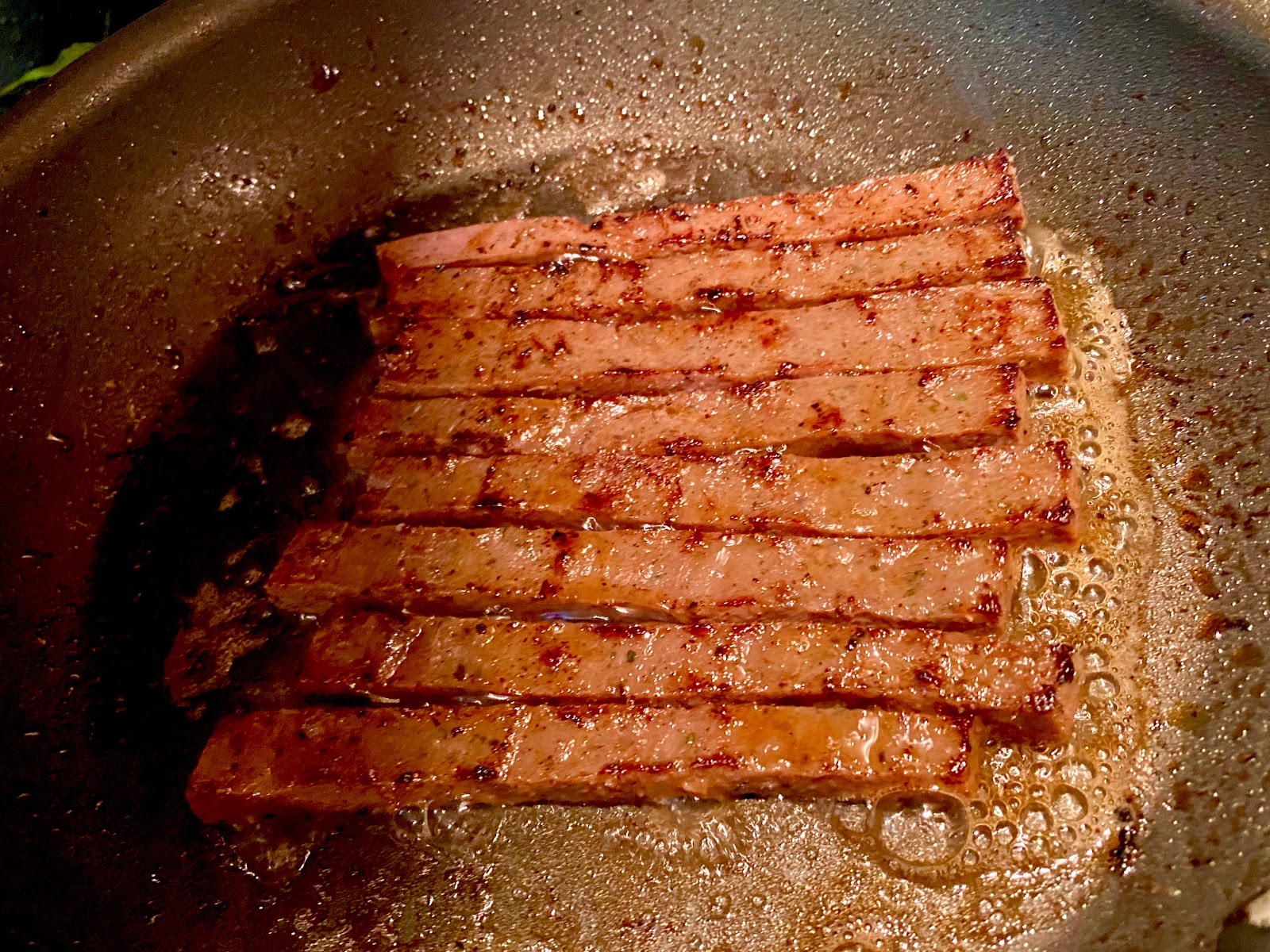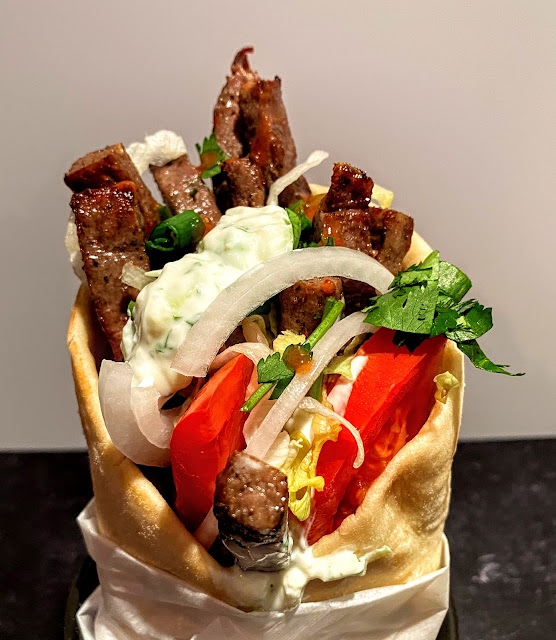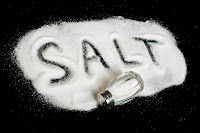Gyro (pronounced YEE-roh) Sous-Vide
 Three years in the making, but I finally made Gyro meat that I am willing to boast about. This version, aka my version, rises to the level of being worthy of a Post. I probably should name the post "The Laudable Gyro." Let me explain the origins of this project. A few years back, I decided to make this delicious meat but ran into a few obstacles. I was never happy with any of the recipes online, and I thought many of the methods and molding techniques did not produce great results. I've had my fair share of Gyro's and ate them just about everywhere I had visited. With my taste buds as my guide, I began my journey.
Three years in the making, but I finally made Gyro meat that I am willing to boast about. This version, aka my version, rises to the level of being worthy of a Post. I probably should name the post "The Laudable Gyro." Let me explain the origins of this project. A few years back, I decided to make this delicious meat but ran into a few obstacles. I was never happy with any of the recipes online, and I thought many of the methods and molding techniques did not produce great results. I've had my fair share of Gyro's and ate them just about everywhere I had visited. With my taste buds as my guide, I began my journey.As a point is of reference, this is a Doner Kebab. The average person most likely has never heard of Doner Kebab, but we all know Gyro. All the greeks places I go to serve the Doner version but call it Gyro. Are they wrong? I don't care because it's all good eats.
 |
| Click on pic to make larger |
Replicating my recipes is possible because I use percentages for everything. All the spices to be added are expressed as a percentage of the meat's weight. Percentages can be used to standardize recipes regardless of batch size. I use the metric system for everything for accuracy and ease of use. I.e., if you are using 2000 grams of meat and you want to calculate what 1% is....2000 X 1% (.01) = 20-Grams. Be cognisant of the Decimal.
I've seen it many times before where someone has miscalculated because of a misplaced decimal. I was contacted about a year ago because a person used one of my recipes, and it was a complete failure. After some queries, it was the misplaced decimal that ruined everything. Let's calculate the grams needed for Fenugreek. 2000 X .1% (.001) = 2-Grams. NOTE: the use of the Activa is essential in this recipe. To my knowledge, Activa RM is used in all commercially prepared Gyro meat. Without it, the meat will be crumbly. Most lunch meat is made this way too.
Unless you use the powdered form of Rosemary, Oregano, Thyme, or Marjoram, they will have to be processed using a spicemill or coffee grinder into a powder. Using them whole will affect the binding and taste. Once everything is measured out place in a suitable bowl.
 You can use whatever meat blend you want, but I find that 50/50 of Lamb and Beef work very well. I prefer to make my own grind, and for this recipe, all I had on hand was Beef. The Beef Grind was a 75/25 of Short-Ribs, Top-Sirloin, and Brisket. I didn't have any Lamb on hand, so I purchased it at the store. If you are going to grind your own meat specifically for Gyro, finish with a 1/8-Inch grinding plate. Anyhow, the first thing you want to do is hand mix the lamb and beef in a large bowl.
You can use whatever meat blend you want, but I find that 50/50 of Lamb and Beef work very well. I prefer to make my own grind, and for this recipe, all I had on hand was Beef. The Beef Grind was a 75/25 of Short-Ribs, Top-Sirloin, and Brisket. I didn't have any Lamb on hand, so I purchased it at the store. If you are going to grind your own meat specifically for Gyro, finish with a 1/8-Inch grinding plate. Anyhow, the first thing you want to do is hand mix the lamb and beef in a large bowl.
This particular batch weighted 2412-Grams.

I have a 5-Quart Kitchen aid, and it's the best tool for this job. You could do it by hand, but the results won't be as good as working with a mixer. I mixer can comfortably handle 1200g. Make sure to use the Dough hook.
Why use a dough Hook instead of a Paddle?

I have a 5-Quart Kitchen aid, and it's the best tool for this job. You could do it by hand, but the results won't be as good as working with a mixer. I mixer can comfortably handle 1200g. Make sure to use the Dough hook.
Why use a dough Hook instead of a Paddle?
No Fat Smearing.
Less Friction and less heat with Hook.
Mixer and handle copious amounts.
Produces better texture.
No fat wrapping (fat will wrap around paddle).
The paddle will break up the fat and may liquify because of generated heat.
Better consistency.
The meat weighed in at 2412g/2 = 1206-Grams. Weigh out the spices and herbs and divide them by 2. Working in batches start mixer out on low and run for a minute or so. The goal is to make a lump of sticky meat. It's all about protein extraction, binding, and emulsification. This is similar to HOT-DOG making.
Run the machine on low and, if necessary, scrape down the bowl. Using a Teaspoon as your guide toss in the spice mixture. Now, this is very important, and I cannot tell you how much ICE-Water you will need. The meat will appear dry, so start with 1/4 cup of ICE-Water and occasionally add while mixing. Everything needs to form a paste, appear to be wet and sticky. This should take about 7-10 Minutes. Now do the other half.
Run the machine on low and, if necessary, scrape down the bowl. Using a Teaspoon as your guide toss in the spice mixture. Now, this is very important, and I cannot tell you how much ICE-Water you will need. The meat will appear dry, so start with 1/4 cup of ICE-Water and occasionally add while mixing. Everything needs to form a paste, appear to be wet and sticky. This should take about 7-10 Minutes. Now do the other half.
This is what it looks like when it's all done. It's wet and sticky.
You will need 600-Grams for the Half Sheets and 1200-Grams for full sheets.

This is a full sheet. Spray down the sheet-pan with non-stick spray. Dump 1200-Grams out on the sheet pan and using your hands spread out. You may have to use some Ice-Water to help with spreading out the meat. You can also use a large metal spatula to help. It helps to keep your hands wet.
After spreading out the meat, place parchment paper on top. Using a rolling pin or something similar smooth out. The thickness should be around 3/16" or 5-MM. Place another sheet pan on top and press down.
Option "B"
Use a 1/2 sheet pan. It will take 600-Grams of Gyro meat.
The Food Saver Expandable bags or the 15-inch Bags will work well the 1/2 sheets.
Make sure when you place in the cooking vessel, you leave enough room for water circulation. I used cookie racks and muffin tins.
Sous-Vid-Process at 145℉ for 30-45-Minutes to pasteurize. Even if the thickness was 10mm, it would still be pasteurized at 30-Minutes. At the thickest part, it only measured 5mm. I never go beyond 45-Minutes!!! The secret is to process with a minimum amount of time. Less time means less fat and moisture loss.
The decision to use a sheet pans came to me after trying other methods and observing their shortcomings. Loaf-Pans give up to much Fat and Moisture. How about large casings or large cylinder Gyros? They're great if you want to slice and sear to develop more flavor. Having done that, this method is better IMO. I've seen people make the large cylinders but only sear the outside and serve. Not that tasty. That's why most use a Gyro Vertical Broiler/Rotisserie that way each slice is seared. The sheet pan method is excellent because you can slice and sear. Also, freezing portions are convenient too.

Step Down, Cooling- I learned this from a dear friend. It's noteworthy to mention this method was created by CREA. Resting food and why we do it can be found HERE. Lowering the temperature in steps will improve the texture and help the exudated moisture be reabsorbed. What do I do? 10-15 minutes at room temp followed by another 10-20 Minutes with cold tap water (I use an aquarium pump to circulate water). Following this method Shock Ice-Water
Shock in a large container with a lot of ice. I always use an aquarium water pump to circulate Ice-Water. I've collected data to suggest there's a 25% improvement on the descending temperature. Thermodynamically when you consider conduction, convection, and the added benefit circulating water, the descending water temp is hastened. Would you ever consider buying an Immersion circulator that doesn't circulate? Circulating water creates a uniformed environment and is especially helpful when there is a change of state, i.e., Frozen->Thawed->Vapor, etc.)


Unleashed from its bag. Because of the low temp, ingredients, and the short time there was virtually no purge. Corner trimmed off using a pizza cutter.
Flawless...

Beautiful...
Sous-Vid-Process at 145℉ for 30-45-Minutes to pasteurize. Even if the thickness was 10mm, it would still be pasteurized at 30-Minutes. At the thickest part, it only measured 5mm. I never go beyond 45-Minutes!!! The secret is to process with a minimum amount of time. Less time means less fat and moisture loss.
The decision to use a sheet pans came to me after trying other methods and observing their shortcomings. Loaf-Pans give up to much Fat and Moisture. How about large casings or large cylinder Gyros? They're great if you want to slice and sear to develop more flavor. Having done that, this method is better IMO. I've seen people make the large cylinders but only sear the outside and serve. Not that tasty. That's why most use a Gyro Vertical Broiler/Rotisserie that way each slice is seared. The sheet pan method is excellent because you can slice and sear. Also, freezing portions are convenient too.

Step Down, Cooling- I learned this from a dear friend. It's noteworthy to mention this method was created by CREA. Resting food and why we do it can be found HERE. Lowering the temperature in steps will improve the texture and help the exudated moisture be reabsorbed. What do I do? 10-15 minutes at room temp followed by another 10-20 Minutes with cold tap water (I use an aquarium pump to circulate water). Following this method Shock Ice-Water
Shock in a large container with a lot of ice. I always use an aquarium water pump to circulate Ice-Water. I've collected data to suggest there's a 25% improvement on the descending temperature. Thermodynamically when you consider conduction, convection, and the added benefit circulating water, the descending water temp is hastened. Would you ever consider buying an Immersion circulator that doesn't circulate? Circulating water creates a uniformed environment and is especially helpful when there is a change of state, i.e., Frozen->Thawed->Vapor, etc.)


Unleashed from its bag. Because of the low temp, ingredients, and the short time there was virtually no purge. Corner trimmed off using a pizza cutter.
Flawless...

Beautiful...
More Pics and Recipes below....
Click on pics to make bigger...
How to assemble- This is what I do...Warm Pita Bread in skillet. Add some Yogurt sauce, Sprinkle on Green Onion, Cilantro, Hot-Sauce, Sliced White Onion, a few slices of Tomato. Toss on some Gyro meat and wrap with parchment paper. Top with some more Yogurt Sauce and Hot-Sauce.
 |
| Click on pics to make bigger... |

🔴🔴🔴🔴🔴🔴🔴🔴🔴🔴🔴🔴🔴🔴🔴🔴🔴🔴🔴🔴🔴🔴🔴🔴🔴🔴🔴🔴🔴🔴🔴🔴🔴🔴🔴🔴🔴🔴🔴🔴🔴🔴🔴🔴🔴🔴🔴🔴🔴
Garlic cloves come in all different sizes, but I used about 4 large ones crushed. Chopping will not work, so make sure to use a garlic press. Maybe 2-Tablespoons of finely chopped Dill and 1-Tablespoon of finely chopped mint. You be the judge. Taste as you go along. You can use a regular cucumber or an English one, but make sure to scoop out the seeds. Use large a grater or a Microplane with large openings. Grate the cucumber and sprinkle on some salt and toss. Let the mixture sit for 15-Min to remove excess moisture. Do not rinse. Use a Cheesecloth or a Nutbag to strain (use your hands to squeeze out water). I used about half the zest and most of the juice from a lemon. Add some salt if needed and give it a taste. Add salt at the end. Let's not forget the cucumber was already salted.
🔴🔴🔴🔴🔴🔴🔴🔴🔴🔴🔴🔴🔴🔴🔴🔴🔴🔴🔴🔴🔴🔴🔴🔴🔴🔴🔴🔴🔴🔴🔴🔴🔴🔴🔴🔴🔴🔴🔴🔴🔴🔴🔴🔴🔴🔴🔴🔴🔴
PITA BREAD
TOP OF PAGE
Note: I searched the internet for the perfect Pita-Bread, and this was the standard recipe. Having made this twice now and looking at the photos, my first batch was way better.
1 package active dry yeast or .25oz
1 cup of warm water (80-105 degrees)
1 package active dry yeast or .25oz
1 cup of warm water (80-105 degrees)
1 cup all-purpose flour
1 1/2 tablespoons olive oil
1 3/4 teaspoons salt
1 3/4 cups all-purpose flour, or more
Start by making a loose sponge: Combine the yeast, warm water, and 1 cup flour into the bowl of a stand-up mixer. Whisk together and let stand 15 – 20 minutes for the sponge to a bubble and rise slightly.
Continue making the dough: Pour in the 1 1/2 tablespoons of olive oil and salt into the sponge. Add the 1 3/4 cup flour. Using the dough hook, mix at low speed until the dough is soft, supple, and slightly sticky. If dough sticks to the side of the bowl, add 1/4 cup more flour, just a little at a time.
Turn the dough into a lightly oiled bowl and cover with plastic wrap. Allow doubling in size; about 1-hour using rapid rise yeast, 2 hours for regular yeast.
When risen, remove the dough from the bowl and place it on a lightly floured board. Weigh the dough and divide by 5 to scale. Gently form into an oval, semi-flat shape. Use a knife to cut into 5 equally shaped balls (mine weighed 140- grams each). Form each piece into a small round ball by tucking the edges under and forming a smooth top. Cover dough balls with a lightly oiled plastic wrap and allow to rest for 30 minutes. Note- if you want to make smaller ones divide by a large number.
Begin to roll out each dough ball on a lightly floured board, about 1/4 inch thick. Allow resting for 5 minutes while beginning to heat a cast iron skillet lightly brushed with a touch of olive oil to medium-high heat. Lay pita bread into a hot skillet and cook until dough begins to puff up, and the bottom has golden brown spots and blisters, about 3 minutes. Flip, cook 2 more minutes, and flip back onto the first side to cook for about 30 seconds. The pita will begin to puff up and fill with hot air. Stack cooked bread on a plate to cool.
🔴🔴🔴🔴🔴🔴🔴🔴🔴🔴🔴🔴🔴🔴🔴🔴🔴🔴🔴🔴🔴🔴🔴🔴🔴🔴🔴🔴🔴🔴🔴🔴🔴🔴🔴🔴🔴🔴🔴🔴🔴🔴🔴🔴🔴🔴🔴🔴🔴
🔴🔴🔴🔴🔴🔴🔴🔴🔴🔴🔴🔴🔴🔴🔴🔴🔴🔴🔴🔴🔴🔴🔴🔴🔴🔴🔴🔴🔴🔴🔴🔴🔴🔴🔴🔴🔴🔴🔴🔴🔴🔴🔴🔴🔴🔴🔴🔴🔴
TOP OF PAGE






































Comments
Post a Comment